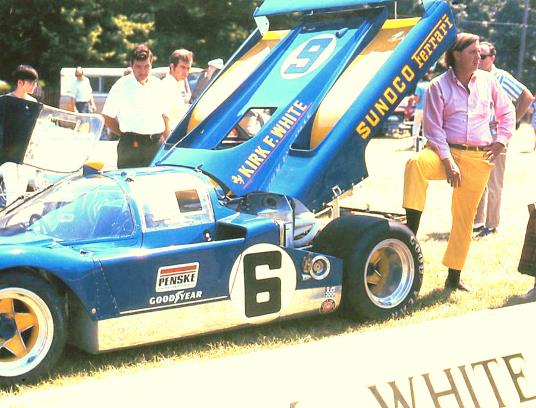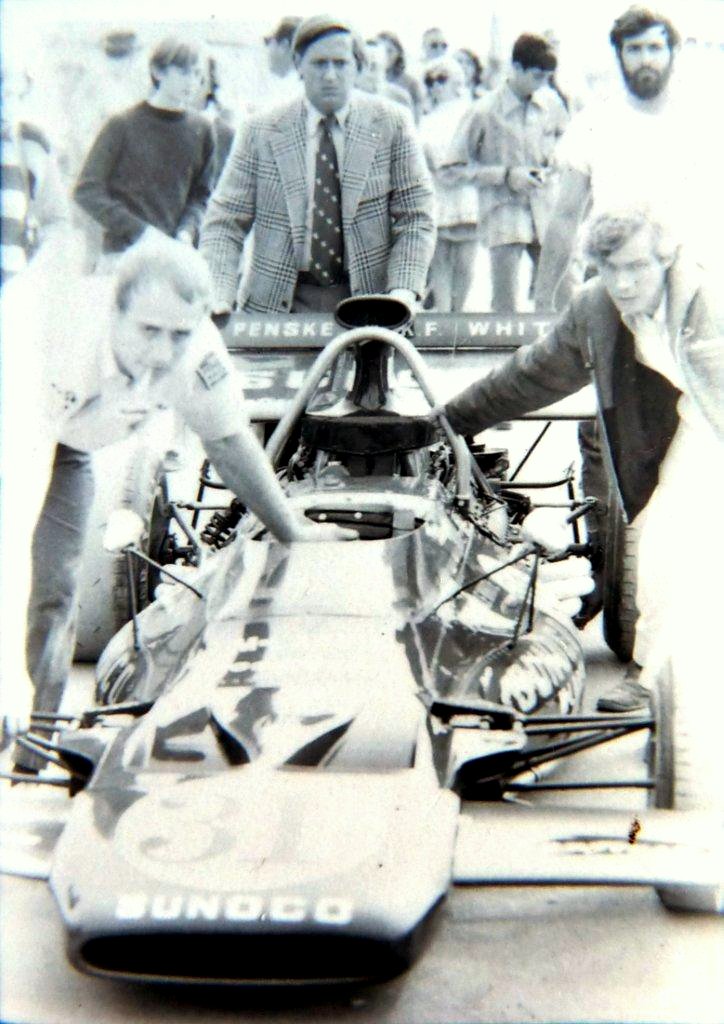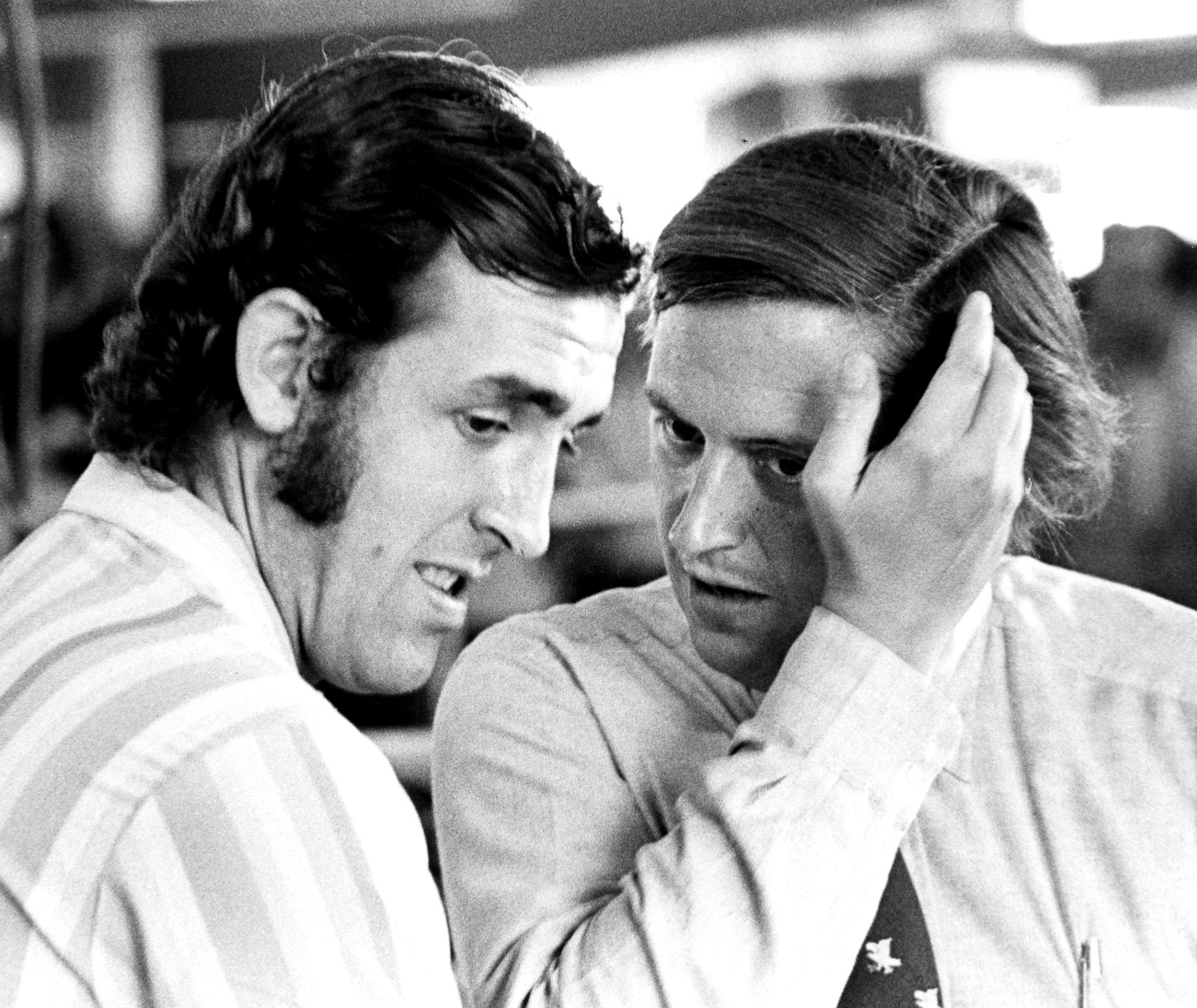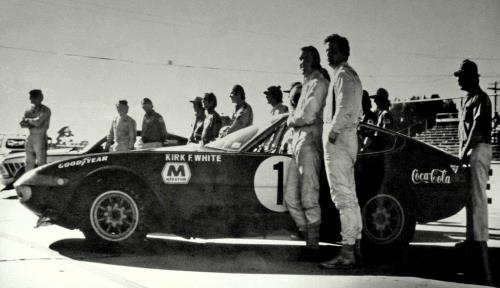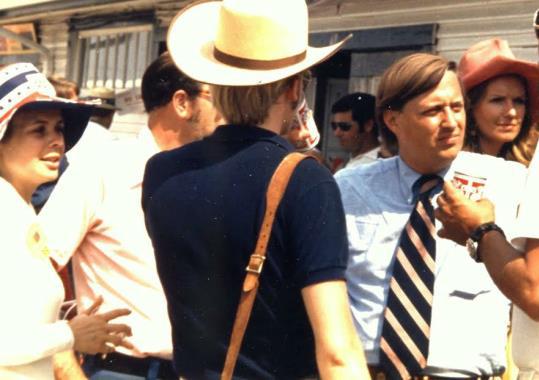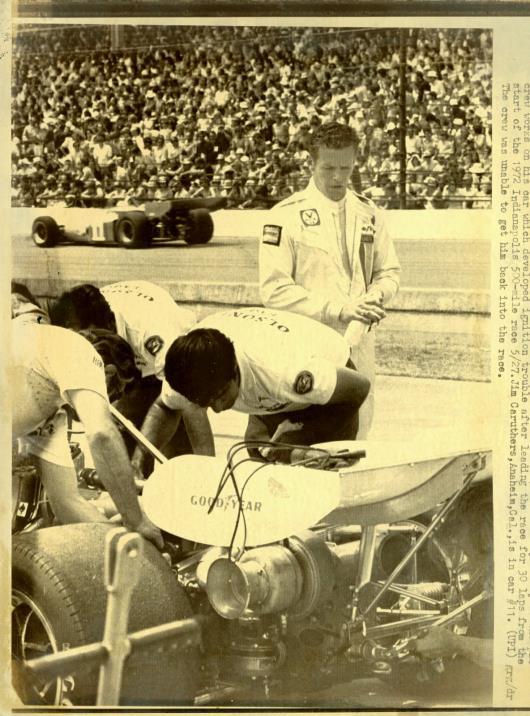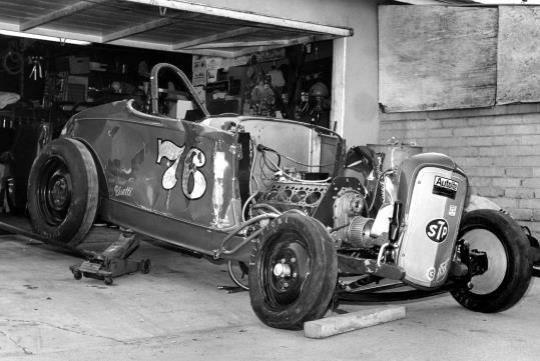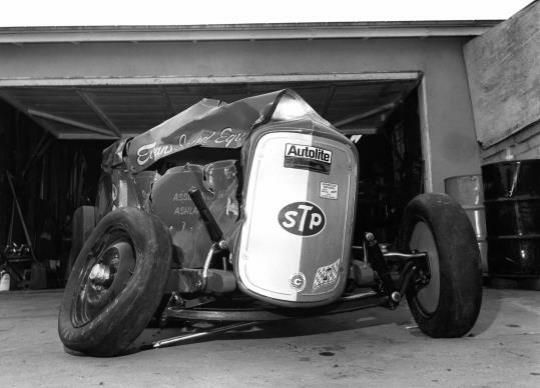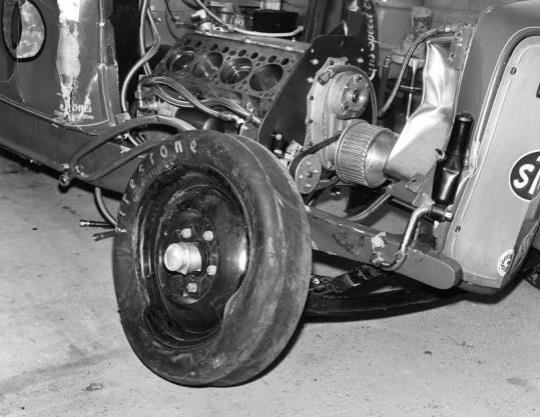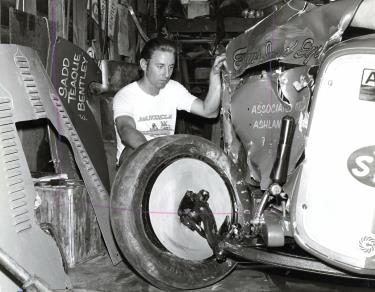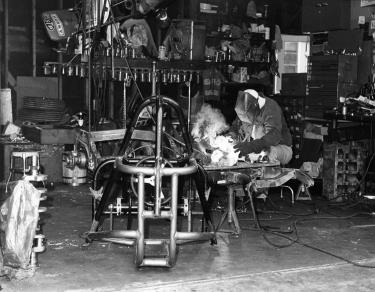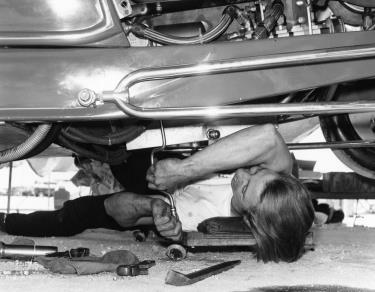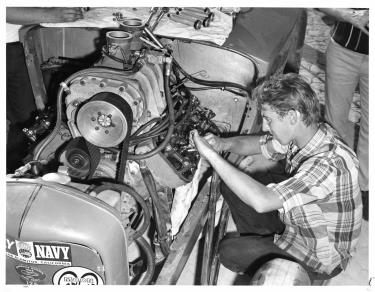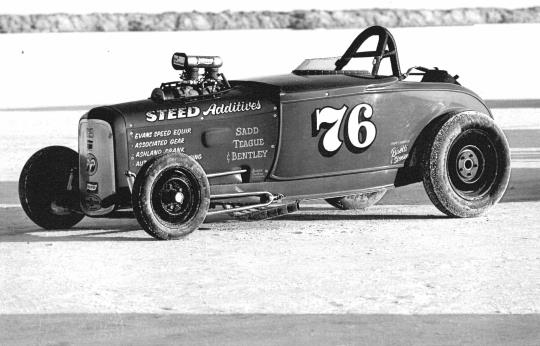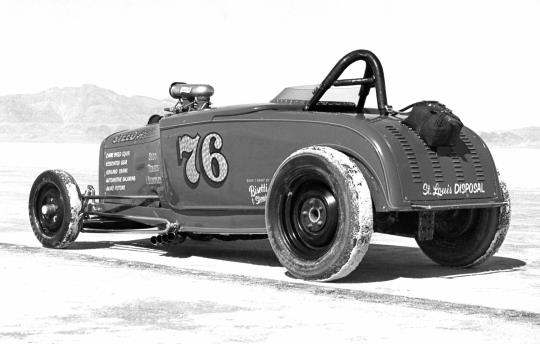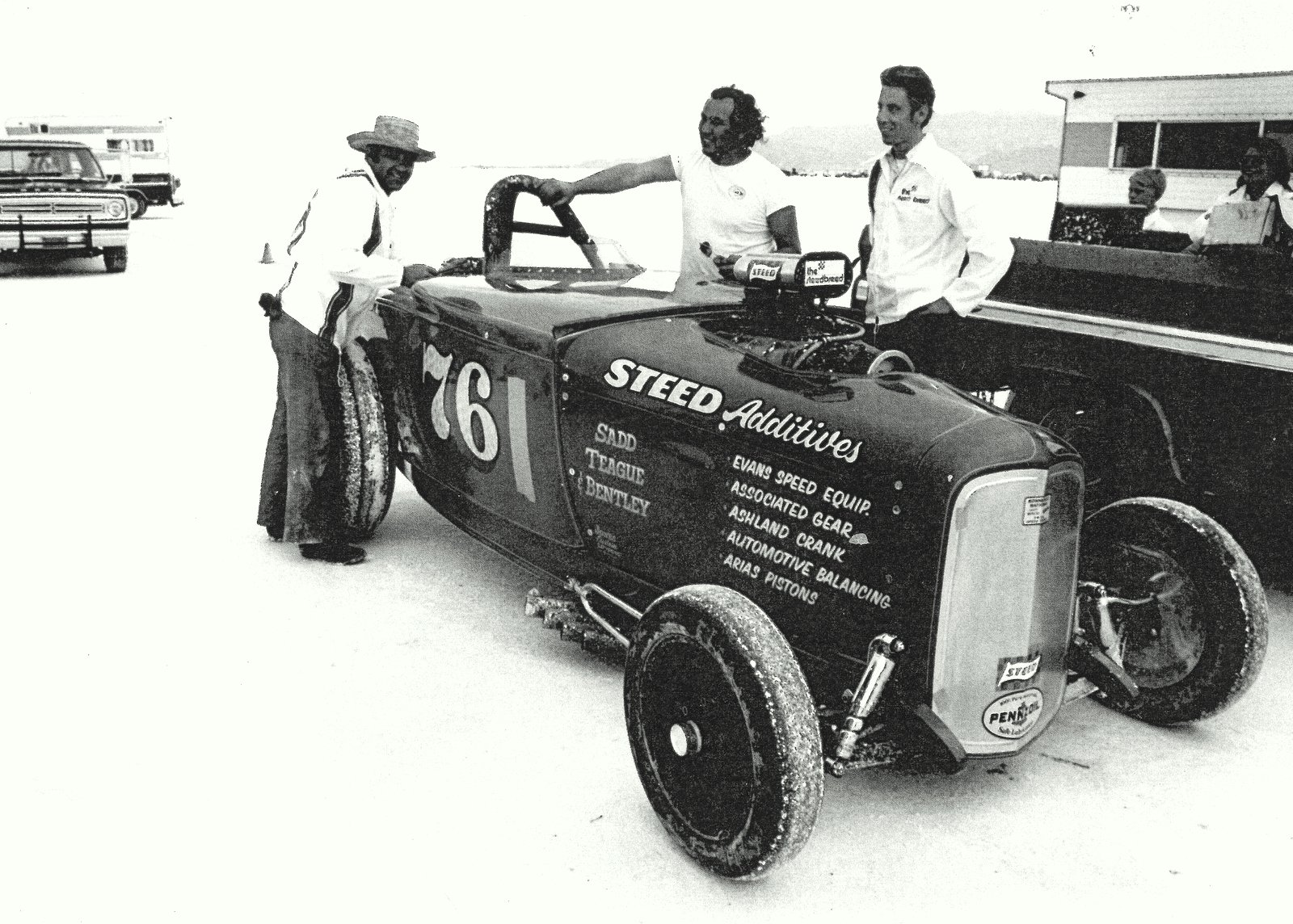610
WHERE DID WE GO FROM THERE . . .
We went home from that 1971 Watkins Glen six Hour knowing we had campaigned the best Group 5 endurance racing Ferrari of all time.
We just hadn’t won a race with that fabulous car. Three pole positions, led all contests except LeMans, but spent way too much time trying to set right the insidious obstacles that Lady Luck had squarely dropped on us!
Still it was an incredibly great experience especially for the group of us out of 63rd Street!
(. . . What if Roger Penske hadn’t stopped that early morning in June of ‘70 and lit the fuse that brought Ferrari # 1040 to life?? . . .)
Chapter 21
The photograph above was taken at the annual New Hope Automobile Show held in early August 1971. And, there I was, with my foot propped on the rear tire of our Ferrari 512, slowly absorbing the fact that our great racing Ferrari had become, simply a historic relic.
I am clearly attempting to peer into the distance to see where we were headed next.
We had four or five cars entered in the New Hope show that year. Our entire crew was spending that weekend at the beautiful Black Bass Inn along the Delaware River in Lumberville Pennsylvania.
611
One might say a bit of needless expense for such a small operation at a local show . . . and it wasn’t the first incident of our having spent too much, no make that needlessly indulged ourselves.
THE FIA FALL MEETING . . . As I mentioned earlier, I had gathered some pretty strong people to petition the world sanctioning body, through the FIA, to allow the fabulous Group 5 Ferrari 512’s and the Porsche 917’s to continue racing.
But, after gaining some traction with the effort in the New York fall ACCUS meeting, it was ruled out overseas.
And again, these activities had little or nothing to do with the buying and selling of Ferraris, Porsches, or Jaguars, which was our business!
We were just banging away at being big time automobile racing guys.
Roger Penske invited me to come aboard for their McLaren Formula One pursuit in the two North American races in the fall, first in Canada then Watkins Glen.
( . . . Really, Kirk??)
The financial gain in such a venture into Formula 1 in those days was negligible at best . . .)
Mark, however, brought the Sunoco McLaren F1 third in a very rainy Canadian Grand Prix. It was Mark’s very first Formula 1 Race.
The Penske McLaren came to Watkins Glen, anxious to extend Mark’s Formula One experience. Woody Woodard was the Chief Mechanic. The car was quick, and Mark and Woody were making changes here and there in the suspension. The changes were done quietly, hoping to not share with Teddy Mayer and the McLaren factory team.
Everyone had been watching the weather forecasts for Trenton, New Jersey. There was a USAC Championship race that had been rained out earlier in the season. The make-up race was scheduled to be run this coming weekend conflicting with the F1 race at the Glen, and Mark would have to attend the Trenton race contractually.
612
But, early in the week they were calling for rain again in Trenton.
Race day morning it appeared the Trenton race would run under relatively clear skies. Mark was flown to Trenton and David Hobbs hastily stepped into the McLaren on race day at the Glen.
Roger had called me late Saturday from Detroit. He would not be coming to Watkins Glen, basically making me responsible for maintaining the Penske image at the Glen.
. . . to the starting Grid, Watkins Glen Fl, 1971
David was quite a bit taller than Mark which made driving the F1 car very difficult as David’s head was without any support from the roll bar, and the G-Forces made it impossible to keep his head upright. Having to sight through the full-face Bell helmet with his head bent backward skewed his forward vision. Lesser drivers might well have parked the McLaren. David drove a commendable race bringing the car tenth.
We may be able to have your legs shortened . . .
And thus ended the 1971 automobile racing season for Kirk F. White Motorcars.
But wait, there’s more! Kirk F. White Motorcars, very late in 1971, was appointed the exclusive United States distributor for the McLaren Can Am cars through Trojan, Ltd. The Can Am McLarens arrived in an unappealing white Gel coat. They took some real imagination to visualize the finished product. The mark-up was pretty thin, but, we did get them all sold.
Finally we were asked (urged . . .) to participate in McLaren’s effort in sending David Hobbs to drive in the Tasman series in Australia and New Zealand.
We signed up for that at considerable expense.
It was like we had signs hanging everywhere around 63rd Street saying:
613
. . . Hey! Hit these suckers up! They’ll about do any damn thing you racer guys can dream up!! . . .
And, of course, for 1972 we wanted to keep going with a racing effort that could at least approach the Ferrari 512 program.
Sun Oil told Roger they were no longer interested in joint sponsorship with anyone. They would simply take over his entire racing program. Not that we had been more than a small bit of his 1971 program, but it sure put us on the map.
Ferrari certainly wasn’t going to make a fresh 312 prototype available to the unauthorized Ferrari hot rod shop on 63rd Street in Philadelphia.
As a company, we wanted to do something with a Ferrari automobile, and so we chose to prepare and run a 365 GTB/4Daytona at Sebring. They were real freight trains and consistently finished on up near the top in many of the long distance races.
Marathon Oil in Ohio was approached, and I signed up a tidy bit of sponsorship money. Marathon was a quality company and expected a quality effort from their racing teams.
We engaged Holman & Moody to prepare the car. They’d won LeMans hadn’t they? Marathon Oil got behind us, and David Hobbs and Skip Scott were brought on board to drive. Skip had won the European Championship in the Essex Wire Shelby Cobra.
We couldn’t get the Daytona set up in time to race at the 24 Hours of Daytona, but we were assured that the Ferrari would be ready for Sebring.
We decided to go to the 24 Hours of Daytona to “scope it out”, whatever that meant. Skip Scott at the time was executive vice president of the Penn Central Railroad’s charter jet aircraft division! So in going to Daytona, Skip pressed a stretched Lear Jet into service to get us there. Once there, we didn’t really pay proper attention to the GT class cars which we would be bumping heads with at Sebring. It became a social gathering. I don’t recall spending significant time really digging into what the other Daytona’s were actually executing during the 24 Hours of Daytona.
614
By the time it got to be Sunday afternoon, it had been discovered that it was my birthday and our group had grown larger. So, Scott had sent for a Falcon Jet. Skip had arranged a dinner at a club on Chubb Cay in the Bahamas.
We were all going to fly to Chubb Cay in the Bahamas for dinner!! (What the Hell ?? !!)
Celebrating my birthday on Chubb Cay led to too much “refreshment” for some. So, late that evening, by the time we touched down in Jacksonville to clear US Customs, we were all tired of each other.
Then we found we were all going to be spending additional time with each other. The igniter plug on the starboard engine wouldn’t light off the engine!
It was now so damn late, and no line mechanics would be on the job until 8 AM tomorrow! Two of our still over-refreshed types thought they could clear the igniter plug.
Thankfully, they couldn’t, and by the time we got back into Philadelphia Monday morning we all simply wanted to be rid of each other.
“ . . . Shoulda’ . . . Coulda . . .”
I went down to Holman & Moody for the dyno runs on the motors in mid-February and watched through the window of their dynamometer room. Directly upon firing, the engine on the dyno started to spew oil from four different sources. I questioned the mechanics on how much oil pressure they were running. It was well over 100 psi.They knew that, and then we spent the next long bit of time attempting to locate the oil pressure relief valve. Finally they said they’d get back to me on that!!
Right there, at that moment, I should have shut the whole project down, but I was assured the car would be “race ready” for Sebring in March!
615
We filed an entry for the 12 Hours of Sebring. We were given a rapid affirmative response and an accompanying letter outlining all the special accommodations we were being given.
I distinctly remember having a “we don’t deserve those accommodations!” reaction. We hadn’t earned a damn thing. Things were being handed to us based on our having been part of the Penske effort the year prior.
In actuality, we were simply rookies trying to act like Major Leaguers.
Just let us see if we can sort this effort out and run with the big dogs!
We got to Sebring as early as you were allowed and the Ferrari ran well. The motor had plenty of power and Howard Brown from Induction Associates was the crew chief. He responded to David Hobbs’ advice on setting up the car, and we ended up as clearly the fastest in the GT class. David had to literally set the rear suspension from scratch!
David Hobbs, Skip Scott, Howard Brown at the rear . . .
I began to feel a bit better about the whole thing. The race started and we were doing well, leading the class. Hobbs came in and Scott took over. Things rolled along pretty well, and then Scott was late.
Then he was very late, and finally he walked into the pit. “Car just wouldn’t shift . . .” Scott said.
Requesting elaboration on the matter brought nothing new. The only clear aspect was that Skip had returned to the pit on foot. Two mechanics were dispatched and discovered a link in the shifting mechanism had fallen away.
Now Skip Scott was an extremely good race driver, but mechanically he left a lot to be desired. Had he known what to do, he probably could have simply knocked the Ferrari into a gear, any gear, and limped it back to the pit.
We were done.
616
BACK TO BUSINESS . . .
We had actually refired the car sales at 63rd Street and things were looking OK. But, just as we were returning to planet earth . . .
“WAIT, HERE CAME AN OPPORTUNITY . . .”
Dan Gurney’s All American Racers had quietly designed and built an incredibly rapid Gurney Eagle for Bobby Unser to run the USAC Championship Trail. It had tested at sensational speeds.
So, with an invitation to come aboard as an associate sponsor, we joined the effort; and that Eagle went to the opening race in Phoenix and won the race going away.
Bobby Unser had served notice, almost effortlessly, that his Eagle was the car to beat.
The Dan Gurney Eagle, in the hands of Bobby Unser, ruled the month of May in 1972 at the Indianapolis Motor Speedway; and Bobby literally smashed the qualifying record by more than 17 miles per hour, securing the pole position at 195.940.
Oh boy, this was one race effort that was going to work out! Maybe, even, really work out!
On the way to the start of the 500 Roger Penske came past me, slapped me on the back and said:
“Boy, you really know how to pick ‘em . . .”
Yeah, we were bulletproof for the first 30 laps as Bobby was steadily walking away from the field on his way to victory lane.
Then, over the radio, a truckload of swearing and Bobby coasted into the pit. The team was all over the car. The failure of an unstressed component in the ignition system ended the day for the team that had ruled the Speedway for all of May 1971 . . .
Race Day Morning 1972 Indianapolis 500
617
The picture below captures the terrible moment when Bobby has stepped out of the car, signaling all those involved that he is done. Too far back at that point . . .
We stayed to watch Mark Donohue win his first Indianapolis 500.
THE KIRK F. WHITE 2nd ANNUAL ANTIQUE AND CLASSIC CAR AUCTION . . .
Yes, we had held the second auction in early May, moving it to the beautiful Cabrini College in Radnor, Pennsylvania. The Nuns who ran the campus were plenty tough to deal with. The rent was staggering, and the ground rules were pretty restrictive.
The day of the sale was clear, and the weather was brisk. The field of cars, though bigger in number, lacked the colorful palette that we’d had in ’71.
When I arrived Saturday morning, the first “vehicle” I encountered was a Renault World War I tank which someone had felt the need to move around more than a little bit. I could see a substantial re-paving bill from the Sisters . . .
The sale was hugely attended and the auction would have made a tidy profit, but all the cash that was taken in was mysteriously “lost!!”
Yes, I know where it went, but I’d never be able to prove it . . .
LET’S WIND THIS UP . . .
We continued through the balance of 1972, wildly overstaffed, watching the “get back to basics ball” keep rolling all around us, but only occasionally did we stop to put our eye on it.
We were too busy opening divisions, branch offices, distributorships, and the crowning blow was to fund a classic car restoration facility 52 miles from 63rd Street, that turned out to be run by a grizzled old crook!
. . . The tremendous let down . . .
618
We had grown from an efficient four, to sixteen employees somehow, (ten of which were decidedly unnecessary)!! (WTF??)
Now you, dear reader, have had to wander through these first several pages of this Chapter taking in an almost unbroken string of sad tales, wretched excess, and steps taken badly . . .
So, suffice it to say, most of 1972 and the beginning of 1973 were not anything to write home about . . .
But I’m going to send you on your way with a walloping great true story that opened in late 1972 and carried into 1973 . . .
SADD, TEAGUE, AND BENTLEY ’29 FORD ROADSTER, CIRCA 1973
All the photographs and a good many of the details in this story are courtesy of the legendary Greg Sharp.
Bonneville, Utah: Imagine a space so flat, so vast, and so wide open, that you can clearly see the curvature of the earth! 30,000 acres of fragile, flat, salt surface.
Since the beginnings of the earliest wheeled conveyances, the Bonneville Salt Flats were utilized for their racing potential. In 1896 the salt flats were part of a coast to coast bicycle race!
In 1914 a racer named Tezlaff drove one of the giant Blitzen Benzes to the staggering speed of 141.73 MPH, and in the thirties, Ab Jenkins lured Sir Malcolm Campbell from Great Britain to run the great Salt Flats.
By 1949 the world Record standards of speed, 200, 300, and 400 miles per hour had been eclipsed on the fabled course.
The first hot rod event was the inaugural “Speed Weeks” held in 1949. For the land speed record chasing hot rodders, Speed Weeks at Bonneville is Mecca, the Holy Grail. A class record at Bonneville is as good as it gets.
This is a true and wonderful tale that took place late in 1972 and carried in 1973. It is precisely the type of thing that you couldn’t possibly dream of carrying off today.
619
The people involved comprised a handful of automobile, hot rod, and racing guys. There was virtually no paperwork, there were no meetings, no committees, no “corporate,” and most essentially, no “lawyers!”
In early 1973 I was in my office skimming through the December 1972 issue of Hot Rod Magazine. Hot rodding was still, very much, something I had a keen interest in.
I came upon an article Tom Senter had written. A heartbreaking account of the demise of the Sadd, Teague, and Bentley Chrysler Hemi powered ’29 Ford highboy roadster. They had suffered a terrifically bad head on accident at the close of the 1972 Speed Weeks event.
The accident took place in the early darkness on a return road with a Ford Ranchero. The ST&B car had no lights, and the Ford Ranchero that whacked them severely didn’t have his headlights turned on! Sadd, Teague, and Bentley, had just completed a run at 250.8 Miles per hour!
The drivers of both vehicles sustained non-life threatening injuries. Sadd, Teague and Bentley’s ’29 roadster was totaled, really, really, racked, as you can plainly see in the photographs, and their supercharged Chrysler Hemi engine was wiped out.
Sadd, Teague, and Bentley had a big fan base among serious hot rodders. Their ’29 A Ford roadster on ’32 Ford frame rails had been built as a racing hot rod in 1956 when it first carried an Ardun Mercury engine. It had always been a more than notable hot rod.
The team had an amazing knack for pushing the speed envelope. All racing hot rodders do, but ST&B were especially clever, hard at it, guys. That Chrysler Hemi engine of theirs was just wickedly powerful.
Greg Sharp told me recently, that every time that car left to make a run, “you’d get to see three sides of it, three times, as it rocketed off to make a pass!”
Pushing a highboy roadster to speeds of 250 miles per hour was a phenomenal feat.
620
A ’29 A Ford “highboy” roadster has the aerodynamic characteristics of a Virginia tobacco barn.
It’s best explained by an account Tom Senter had written after one of the car’s record runs in 1972.
Let’s let Tom tell it:
“Bonneville 1972 was the year. A 16 year old highboy roadster and two truckloads of hell-raising racers arrived on the salt, as they had done ten times before. Gene shut down the shop (Evans Speed Equipment) and brought the Evans crew with him.
“They qualified the car for the A/FR record right off the trailer on Monday at 237 MPH on the 2 ¼ mile course.”
“The next day they put a taller gear (3:36) in it and Al made a four-mile run at 252 MPH.”
“(To give you an idea of just how much wind that car has to push, Al was timed at 252.98 MPH at the four-mile board, where he shut off. Without using the brakes or chute, he was clocked at the five mile board at 144.59, a loss of 110 MPH in one mile!”
“The thing was a house on wheels!”
Reading the moving account really struck me. These guys had come so far, and accomplished so many great things in hot rodding. The article in Hot Rod ended by saying that this was the end of the road for the well liked triumvirate. The car was just too heavily damaged to be repaired for the ’73 season.
Doubly tragic in that they were ready with a new Hilborn injected, 6-71 supercharged 354 cubic inch Hemi Chrysler engine.
Their dream was the B/FR record in 1973, and past that they had wanted the car to simply be: “The World’s Fastest Roadster.”
621
It was late morning when I had read the article in Hot Rod. I couldn’t get over the fact that after such remarkable strides, that runnin’ fool of a hot rod roadster was finished because of that bizarre accident.
That evening, I couldn’t get the damn story off my mind. I read the article again, and from the far reaches of my “back” brain, I began to come up with a way out there, hare brained scheme. I’d wait and see if all the edges of the idea were still intact the following morning.
The next day I took my, now dog eared, issue of Hot Rod Magazine and went to the masthead page.
Terry Cook was the editor at the time. I knew who he was, and knew he was a “no nonsense” hot rodder.
Shortly after noon, I called the offices of “Hot Rod” an asked for Terry Cook.
He answered the phone . . .
“Terry, this is Kirk White in Philadelphia calling and I . . .”
“Same Kirk White with the Newsletter and the 512 Ferrari this past year?” Terry said.
“Uh, yes . . . “
“What’s up, how can I help you?”
“I’ve been really taken with the awful end to the Sadd, Teague & Bentley roadster in your magazine this month. It was such a needless loss.”
“Let me pose a ‘way out there’ hypothetical question, Terry.” I said.
“If I, and I emphasize the “if,” could get a sponsor to get involved, like right now, and the car got fixed, and it then went to Bonneville to set the record at this year’s Speed Weeks, what could I count on from Hot Rod Magazine, as far as coverage.”
622
Thank God, Terry didn’t just hang up the phone in the middle of that windy wackiness!
“A Multi page article, color photography, anything within reason. ST&B is a great team.
We’d love to see them get it done.”
“How can I reach the team, Terry?” I asked
And, he gave me Al Teague’s telephone number, just like that.
Hmm, okay, what do I do first? Better call Al Teague and see what the real deal is with the car. I didn’t even know if they still had the roadster!
I rang the number and Al Teague answered. I remember thinking, how the hell am I going to spit out this cockamamie tale without him merely putting the phone back in its cradle.
“Al, this is Kirk White in Philadelphia. I’ve red Tom Senter’s article in Hot Rod, and Terry Cook gave me your number” . . .
He was still there; the wire was still open . . .
We lamented the tragedy of it, etc.
“Al, if you had the money to fix the roadster, set it right, and go back to the salt this year, what do you reckon it would take?”
I don’t want to call it a snort, but a derisive utterance came down the line:
“Can’t be done” Al said dejectedly.
“Why?” I asked.
“Just can’t be, that’s all” he said.
My grand Broadway production was unwinding before the opening curtain.
“Is the car gone, did you break it for parts?” I asked.
“No it’s here, in the back.”
623
At this point I think he may have been thinking he’d had enough of this screwball guy in Philadelphia! “What the hell would anyone in Philadelphia know about serious hot rodding?”
“Al, bear with me one more minute here; do you guys want to run the car again? If you had the money would you get the car repaired and go to Speed weeks?”
“Sure, but we can’t, I told you, it would be just way too much money, and time is running out on us . . . he said”
“Okay Al, just quickly, how much money? Just tell me, allowing yourself an edge?” I asked.
At that point he had to be thinking: “OK, asshole, this ought to dust you off the line pretty quick.”
“$4,000” he said.
“All right Al; this is not a joke from this end. Give me a couple of hours and I’ll call you back. Will you be there for the next bit of time?” I asked.
“Yes,” he would be, he said.
I was sure he couldn’t wait to get me off the phone so he could call Terry Cook at Hot Rod Magazine, and give him ‘what for.’
I called Bill Hawthorn (sic) at Marathon Oil. Bill was the top guy in their auto racing sponsorship department. In 1972 Marathon Oil had come on board as the principle sponsor with a Ferrari 365 GTB/4 effort we had mounted for the ’72 season of endurance races. We ran the Sebring 12 hour that year, and in spite of being quick, and the fastest Daytona with David Hobbs and Skip Scott driving, I was disappointed in the results. I had quit the program after Sebring. We returned the money allocated for the other races to Marathon Oil.
624
We were told by a good many people that no one returned sponsor dollars, especially to oil companies! That just wasn’t done.
If nothing else, we were on very good terms with Marathon Oil, and we had recently gotten some sponsorship monies for Gary Bettenhausen’s potent sprint car, running out of Tinley Park, Illinois.
Hawthorn was a real racer, and had a great love and respect for the all types of auto racing.
“Bill, have you got a couple of minutes?” . . . and I walked him through the whole saga.
“So, here’s what it comes down to Bill: I’ve talked with Al Teague, and they’d really like to go back to Bonneville with that roadster, and set the record.
“They’ve already been all around the edges of the record. When they get out there this year, and break it, Terry Cook at Hot Rod Magazine has guaranteed a multi page article with a two page color spread of the car.”
(Hot Rod Magazine in 1973 was by far the largest circulation automobile magazine on earth . . . and Bill knew that.)
“How much do they need?” Bill asked.
I didn’t want those guys to muff their chance or cut any corners for lack of money, so I told
him:
“$5,000.”
“But here’s the deal, Bill. Time is really of the essence and we need to get the money to them like ‘right now’, I said.
At that point another “out of the blue” bit of luck fell into this crazy mix. Marathon was just bringing out their new oil additive, “Steed.”
This would be a great opportunity for Marathon Oil to pick up some mighty good exposure with their new product. Further, Marathon would be the heroes who rode in on their white horses and funded this group, got their hot rod rebuilt, and sent them back to the salt.
625
“We’re just bringing our new “Steed” oil additive out, and to have the product on board a well known, Nitro burning, supercharged, Hemi High Boy would be a strong statement,” Bill said.
“Yes, I can do that program. What do you want me to do?” Bill asked.
I held my breath, and said:
“I’d like you to cut the check for $5,000 today and send it by DHL overnight it to them”
“Okay, we can do that”
“Bill, give me an hour to get all the edges stitched up here, and I’ll call you back.” I said.
I called Al Teague’s number. It rang on forever. Finally, he picked up.
“Al, its Kirk White. Marathon Oil is going to fund your deal; they’ll overnight $5,000 today. I just need to go over with you the logistics of making all this work.”
Al, at first must have thought he was dealing with a grade A nut case. But the further along this conversation went, he began to feel that this wild scheme was maybe, just possibly, going to happen.
My greatest concern was whether or not S,T&B could gather up all their edges from their end and actually make it from a time standpoint. But I forgot I was dealing with top drawer hot rodders. The real ones always just “get it done.”
“I need your address for an overnight DHL delivery of the money. Marathon will send you a simple set of papers covering the sponsorship, logo layouts, advertising rights, etc.”
“Are you really serious about this?” Al asked.
626
“Yeah Al, this is for real. You know how to reach me if you have any questions.” I said.
And, that was that! Two days prior to that conversation, I hadn’t the foggiest notion of who Sadd, Teague and Bentley were! Had it not been for Tom Senter’s moving article, I never would have.
Where to start . . .
Into the night. . .
Endless . . .
. . . No end to it . .
. . . Back on the salt . . .
. . . Three happy racers !
Hot Rod Magazine did their part, and through their sister publication, Rod & Custom, in their December 1973 issue, Petersen Publishing really pulled out all the stops.
Commencing on pages 40 and 41, spread over the bottom half of both pages, was a fantastic color photo of The ST&B “Steed” car at the end of its mind bending 268 MPH run, with the chutes popped. For the next six pages the car is shown in the “page heading” upper left corner of each page! In the results listings, it is referred to as the “Steed High Boy.”
Then, on page 49 of the same issue, Gray Baskerville penned a superb four page piece on the car with eight photographs of the Steed highboy!
The following, taken directly from Baskerville’s article, is a remarkable account, told in Al Teague’s own words, of what took place that historic Wednesday morning August 22, 1973. It is the single best piece this writer has ever read on what it was “really like out there”:
“You see,” Al explained patiently, “we got this new fuel pump which was really too big for the 360-in. “B” motor, so we leaned ‘er down, after the 214-mph off-the-trailer pass, and ran 235 to qualify for the Mark Dees’ 230-mph B/Fuel Roadster record.”
627
“Tuesday the salt was still soggy, but we ran records anyway, and we only turned 231 on the down run before rain wiped out our chances for a return pass. The next morning, that was Wednesday, you remember, the officials let us make our return run and we decided to richen it up .005-in. on the bypass and bump the percentage from 35% to 60%.”
“Well I suited up, Higee made sure I was securely buckled in, then I made my first mistake… I forgot to turn on the electric water pumps.”
“Anyway I pulled the safety wires on the fire bottle valves, motioned the truck to push off, then carefully slid the clutch out. Once the oil pressure lifted to 80 lbs., I flicked on the mag kill, pushed the fuel shutoff to “on” blipped the throttle a couple of times and felt it fire.”
“Man it sounded crisp, but cold, so I clutched it again, goosed the throttle a couple of more times, then let the push truck build up some more speed. By now it was sounding good, so I started slipping out the clutch and eased away from the truck.”
“Oh, it wasn’t lazy at all and wanted to take right off. I came down slowly to about ¼ throttle, and about there the car really started to let me know what was happening; it began to move as soon as I gassed it, but it felt so good and had so much power that it kept breaking traction every time I jumped on it.”
“By now the tach was climbing past 6000 and the tires coupling up when; “bamb,” (sic) it was there at seven grand. I made my shift into high and put it to it, by the time the eight-mile board came flyin’ by.”
“The tach was already reading 7000 and climbing at the seven-mile board, and all I could think of was that the engine would never make it. There was nothing left but to back off for a mile and a half and save it for the last couple of miles. Well, I got back on it in the six-mile, feeding the throttle slow and easy…but it still wanted to break the tires loose at 6500.”
“What I didn’t know was how hot the engine was getting, because of my failure to turn on the pumps. It was really eating the plugs and detonating, and all I could think of was about getting the blower stuck into my mouth!”
628
“I kept telling myself to glance at the tach, then at the oil pressure, then at the temp gauge while tilting my head down to lessen the wind buffeting. By now the car was in a controllable power drift and the oil pressure looked good as we went by the five-mile marker, so I just rode it out until the four-mile when we shut it down.”
“You wouldn’t have believed how it was dieseling, and then it all came to me as soon as I checked the temp gauge. I knew then why the thing had been vibrating so badly. All I could do then was to turn on the water pumps, cool it down, and suddenly get tired.”
And, the late, legendary, Gray Baskerville finished the account with these few words:
“Somehow the tumult after that incredible 268-mph return run made the balance of the meet seem anticlimactic. Even the heroic triumvirate couldn’t retain the momentum generated by that awesome pass. They put in Al’s big 5/8-in., stroker “A” motor and slipped a long-long course 2.27 gear into the old Halibrand. The bite just wasn’t there. All they could manage was a skiddering 250, while taching 290, before the engine gave up Saturday with a case of the cracks in two cylinders.”
“But Sadd, Teague & Bentley had done the thing that Bonneville 25 was all about. They had returned to the salt’s Silver Anniversary with a roadster, a bigger, badder roadster. The perseverance of Nick Sadd, George Bentley and the rest of the crew, the financial aid of Steed Industries, and the behind-the-firewall art work of Al Teague had literally raised the old highboy from the dead to become the world’s fastest roadster, bar none.”
629
“Yea, and it hasn’t stopped there. For encores, the boys rolled the concours-clean “Steed horse” onto El Mirage’s windswept 2.2-mile short course late in September and power drifted it to a thundering 235 mph. It’s precisely that type of record sawing consistency that legends are made of. Maybe that’s why we’re all so high on the Spirit of 76.”
THE REST OF THE STORY . . .
Nineteen years later, at the end of the 1991 season, Al Teague had gone on and set the world’s record for piston driven automobiles at the sensational speed of 432 mile per hour.
The event was big news worldwide for hot rodders. It was nice to know I’d had a tiny role in his life.
Late that same year I had been invited to Jim Lattin’s annual Christmas Party at his museum / shop in southern California. Jim is a good friend, and customer, and had been good enough to include me in his party. At the party, which was always hugely attended, on display was Teague’s record setting streamliner. It was one serious looking piece of hot rodding. Man, that thing was really long. In setting the record he had not only used up every bit of the course, they had actually backed the car off the course, across the road for starting so he’d have a rolling start when he hit the beginning of the course itself. He used up every inch at the far end getting it all gathered back in to a halt.
I asked a friend, if Al Teague was there.
“Yeah, that’s him right over there” He pointed to a very large cluster of people all around him. So many people, that I didn’t really know which one was Al.
“Which one is Al?” I asked.
He pointed over to the group.
630
“He’s the guy in the center there, in the maroon shirt, right next to that really tall character in the orange jersey.”
“OK, now I see him” I said.
I wanted to say hello, but we had never met!
We had just had those brief bits of conversation on the telephone that got them that bit of money, way back in ’73.
“He probably won’t have the foggiest notion of who you are,” I thought. I’m not going to wade into the midst of that adoring throng and make a damn fool of myself.
The party was terrific, and I had an opportunity to visit with several friends. I’d occasionally glance over toward Al, but the throngs were relentless.
“Put it out of your mind, Kirk, he’ll never remember what the hell you’re even talking about.” Hell, it had been so long ago, I wasn’t even sure I knew what the hell I was talking about! Things tend get a little bent out shape over time.
As the party was winding down, I came around a corner, and there was Al Teague, almost by himself.
I walked up to him and put out my hand:
“Al, I’m Kirk White” . . .
Instantly his face broke into a huge smile, and he grabbed my hand, looked me straight in the eye, and said:
“Man, I’ve been waiting twenty years to meet you!” . . .
He was such a great guy, and so easy to talk with, and so damn nice to me. He took me around to meet some of the other guys who had been involved with the effort in ’73. ‘
It was a very special time, and remains one of my most treasured moments in motorsport.
631
As I write this, which I have never done before, I find that I can put it to paper, but any time I try to verbalize this damn tale, I come unglued at the end and the eyes brim over!
As the rodders say: “It’s a bitchin’ tale!”
BWTM . . .
August, 18, 2010: Just as I finished putting this story to paper, I read in the September, 2010 issue of Octane Magazine that a Bugatti Veyron 16.4 (!?) had just set the world’s fastest production car record at 267.8 MPH! The first five replicas, resplendent in their Halloween color scheme of orange and black, have been snapped up at $2.4 million dollars, per car!
Hell, that’s damn near as fast as Sadd, Teague, and Bentley ran 37 years ago, spending Steed’s $5,000 to do it in that “Barn” of a hot rod!
Apples and oranges? I’ll say it is, but what the hell . . .??)
Coming Next: “A Step Into the Future”
Thursday, January 19, 2017


